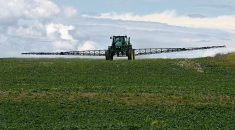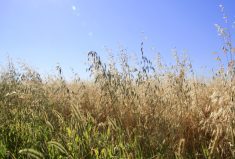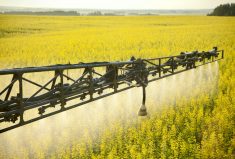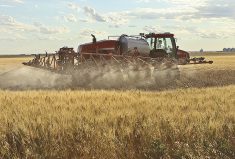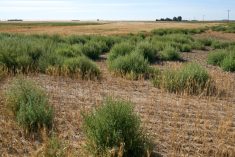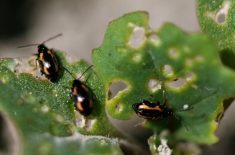Two things happened to glyphosate over the past 15 years — it got a lot more popular and a lot more unpopular at the same time.
There’s no question that most farmers love it.
Although the most recent estimates are a few years old, farm use of glyphosate soared in this century. A major European study released in 2016 pegged global ag use of the herbicide in 2014 at 750 million kilograms of active ingredient — 4.8 times the amount used 14 years earlier. That’s not far off the results from an Alberta Agriculture survey, which found nearly 8.7 million kilograms of active ingredient were sold in the province in 2013, up 330 per cent from 1998.
Read Also

New crop insurer policy enables easier startup for faba beans
Agriculture Financial Services Corporation updated its normals for faba beans, which may open the door for more Canadian producers to feel comfortable growing the pulse crop in the future.
There’s no single reason why glyphosate is the world’s most popular herbicide — there are a bunch, said Charles Geddes, a weed scientist at Agriculture Canada’s Lethbridge research station.
“It has a broad-spectrum activity on both grasses and broadleaf weeds,” said Geddes.
The chemical doesn’t just stay on the spots hit by spray but moves through the entire plant, which “makes it especially good for control of difficult-to-manage weeds. For example, a lot of perennials with an established root system.”
It’s also relatively non-toxic to mammals.
“This is very beneficial,” he said. “It is much less toxic than other herbicides that are out there. When glyphosate was introduced, it ended up replacing the application of some other herbicides that would have been more toxic.”
It also has no residual activity in the soil, and that means it can be used as a pre-emergent herbicide before seeding virtually every crop. And that’s allowed a revolution to occur.
“It has really helped the adoption of zero or reduced tillage in Canada,” said Geddes, noting that means reduced erosion (and less nutrients getting into waterways) along with better retention of moisture.
These attributes, of course, are all well known by farmers.
And they also know about the mounting opposition to the herbicide.
Those include — but are no means limited to — repeated threats by European authorities to ban the chemical; a recent US$289-million jury award to a California groundskeeper with non-Hodgkin lymphoma who blames exposure to the herbicide (with more than 600 similar lawsuits pending); Italy’s shunning of Canadian durum because of very small amounts of glyphosate residues; and, of course, the demonization of both the chemical and its maker, Monsanto (now part of Bayer, which has seen its share price plunge by a third since acquiring the company).
These two views of glyphosate seem irreconcilable, but Geddes looks at the issue through a scientific lens.
“A lot of the research shows that glyphosate is relatively non-toxic compared to many of the other herbicides,” he said. “(However), a lot of that research is looking at acute toxicity as compared to more of a chronic toxicity, which would be exposure to any chemical over a long period of time.”
There’s a lot more research now being done on those long-term effects and it could be another 15 years (or longer) before there’s enough evidence to make a proper risk assessment.
For his part, Geddes isn’t willing to predict what those studies may find.
“As with pretty much all chemicals, it’s pretty much up in the air whether they are toxic or not long term,” he said.
What is clear is that the ability to detect micro levels of chemicals in the environment has changed dramatically, and that could be a game changer.
For example, it was headline news in Italy when tests found traces of glyphosate in some of the country’s popular pasta brands. But the levels were around 30 parts per billion — a tiny fraction of the European Union’s maximum residue limit of 10,000 parts per billion. Still, Italy has gone from being a top importer of Canadian durum to hardly buying any since the government imposed country-of-origin labelling rules. During a trip to Italy in October, Agriculture Minister Lawrence MacAulay admitted “it is not an easy issue and it will not be solved quickly.”
Yet another glyphosate story that is far from over is weeds that have developed resistance to the chemical.
A number of weed species in Western Canada have developed resistance, including kochia, while others have been found in Eastern Canada (including Canada fleabane, giant ragweed, common ragweed, and water hemp) and could make their way here.
“It’s expected with the high use rates that we’re seeing that we’re likely going to see other weeds evolve a high resistance rate to glyphosate as well,” said Geddes. “If you look to the States, which had high rates of glyphosate (use), it had high glyphosate resistance, including a few big ones like palmer amaranth.”
This may be the glyphosate story that will affect crop growers in Alberta the most.
Pesticide makers have joined researchers in urging farmers to vary their herbicide use and switch modes of action to combat the development of more resistant weeds.
“We actually see a greater selection pressure for herbicide resistance in the in-crop or post-emergent herbicide application window,” said Geddes. “It’s very important when you’re adopting these crops not to only use glyphosate as the only in-crop herbicide because the selection pressure is greater at that time.”
This threat has prompted Geddes’s research program to offer a free testing service for growers (contact him at [email protected] for information on submitting a sample of a suspected resistant weed).
The stakes are simply too high to be complacent, he added.
“It’s important that we don’t lose glyphosate as a weed management tool because it’s really allowed for the adoption of many practices like zero tillage,” he said. “That’s really something that we don’t want to go backwards on, and start bringing more conventional tillage back into our rotations.”
One thing is certain: Glyphosate has been one of the top stories since the Alberta Farmer Express was founded 15 years ago, and is going to continue to be one for many years to come.




